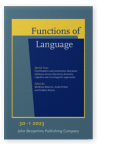Contrast marking variation in Romance and Germanic languages
Crosslinguistic and intralinguistic comparison through task-elicited speech
In research on information structure and discourse cohesion, contrast has been defined in different ways,
depending on the pragmatic/semantic relation established between the propositions involved in the contrast, on the text types and
on other discourse conditions. As a whole, despite – or possibly because of – its vagueness, contrast has proved to be a useful
heuristic tool for characterizing discourse cohesion phenomena. This paper focuses on results from our research concerning
cohesion phenomena in elicited discourse in Romance (Italian, French) and Germanic (German, Dutch) languages and aims to offer a
more precise characterization of contrast against several variation parameters. We take into consideration earlier work on three
tasks (Finite Story, Polarity-Switch Dialogues, Map Task) and add a new one
(Spot the Difference). The comparison between the results allows us to disentangle the following variables:
information units involved in the contrast relation; discourse conditions (monologue vs. dialogue); speakers’ access to
information (shared vs. non-shared); effect of contrast on information in the common ground (alternative maintained vs. rejected).
The aim is to achieve a more fine-grained definition of contrast relations, which allows us to identify and characterize the
divergent behavior of Romance and Germanic languages, and to relate intra- and crosslinguistic differences revealed by speakers’
preferences in speech with structural specificities of the two language groups.
Article outline
- 1.Introduction
- 2.The notion of contrast and parameters for its variation
- 3.Contrastive relations in different tasks
- 3.1
The Finite Story: Contrast on entity or polarity?
- 3.2
Polarity-Switch Dialogues: Polarity contrast
- 3.3A modified version of the Map Task: A different case of polarity contrast
- 3.4
Spot the Difference: Contrast on entities and/or locations
- 4.Discussion and conclusion
- Notes
-
References
